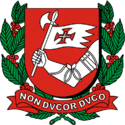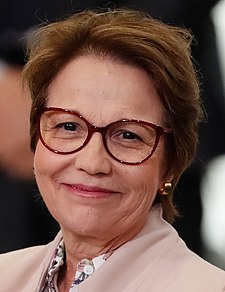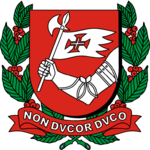Premier of Belmonte: Difference between revisions
No edit summary |
No edit summary |
||
| (29 intermediate revisions by the same user not shown) | |||
| Line 1: | Line 1: | ||
{{Region icon Kylaris}} | {{Region icon Kylaris}} | ||
{{Wip}} | |||
{{Infobox official post | {{Infobox official post | ||
| post = Premier | | post = Premier | ||
| body = Belmonte | | body = Belmonte | ||
| native_name = Premiê de Belmonte | | native_name = <small>Premiê de Belmonte ({{wp|Portuguese language|Luzelese}})</small> | ||
| flag = Belmonte_flag.png | | flag = Belmonte_flag.png | ||
| flagcaption = [[Flag of Belmonte]] | | flagcaption = [[Flag of Belmonte]] | ||
| insignia = Brasão_belmonte.png | | insignia = Brasão_belmonte.png | ||
| insigniacaption = [[Coat of arms of Belmonte]] | | insigniacaption = [[Coat of arms of Belmonte]] | ||
| image = | | image = Tereza_Cristina_em_18_de_julho_de_2019.jpg | ||
| imagesize = 225px | | imagesize = 225px | ||
| incumbent = [[ | | incumbent = [[Rita Maurino]] | ||
| incumbentsince = 05 May | | incumbentsince = 05 May 2015 | ||
| status = {{wp|Head of government}} | | status = {{wp|Head of government}} | ||
| department = [[Government of Belmonte]]<br>[[National Congress of Belmonte]]<br>[[Cabinet of Belmonte|Premier's Office]]<br>[[Cabinet of Belmonte|Cabinet Office]] | | department = [[Government of Belmonte]]<br>[[National Congress of Belmonte]]<br>[[Cabinet of Belmonte|Premier's Office]]<br>[[Cabinet of Belmonte|Cabinet Office]] | ||
| style = {{wp|Prime Minister|Premier}}<br>(informal)<br>{{wp| | | style = {{wp|Prime Minister|Premier}}<br>(informal)<br>{{wp|Excellency}}<br>(formal and international) | ||
| member_of = [[Chamber of Deputies of Belmonte|Chamber of Deputies]]{{·}}[[Cabinet of Belmonte|Cabinet]]{{·}}[[ | | member_of = [[Chamber of Deputies of Belmonte|Chamber of Deputies]]{{·}}[[Cabinet of Belmonte|Cabinet]]{{·}}[[Council of State (Belmonte)|State Council]]{{·}}[[National Defence Council (Belmonte)|National Defence Council]] | ||
| reports_to = [[President of Belmonte|President]] and the [[National Congress of Belmonte|National Congress]] | | reports_to = [[President of Belmonte|President]] and the [[National Congress of Belmonte|National Congress]] | ||
| residence = [[Bensafrim House]] | | residence = [[Bensafrim House]] | ||
| Line 21: | Line 22: | ||
| nominator = [[List of political parties in Belmonte|Political parties]] | | nominator = [[List of political parties in Belmonte|Political parties]] | ||
| appointer = [[President of Belmonte|The President]] | | appointer = [[President of Belmonte|The President]] | ||
| appointer_qualified = The president appoints the leader of the party with the majority of seats in Congress | | appointer_qualified = The president appoints the leader of the party with the majority of seats in Congress | ||
| termlength = {{wp|Term limit|No term limits}} | | termlength = {{wp|Term limit|No term limits}} | ||
| termlength_qualified = As long as the premier has parliamentary support | | termlength_qualified = As long as the premier has parliamentary support | ||
| constituting_instrument = [[Constitution of Belmonte|Constitution]] | | constituting_instrument = [[Constitution of Belmonte|Constitution]] | ||
| formation = 18 October 1836 | | formation = 18 October 1836 | ||
| Line 30: | Line 31: | ||
| website = [http://wwww.belmonte.gov.be wwww.belmonte.gov.be] | | website = [http://wwww.belmonte.gov.be wwww.belmonte.gov.be] | ||
}} | }} | ||
The '''Premier of Belmonte''' ({{wp|Portuguese language| | {{Politics of Belmonte}} | ||
The '''Premier of Belmonte''' ({{wp|Portuguese language|Luzelese}}: ''Premiê de Belmonte''), officialy the '''President of the Council of Ministers of the United Republic of Belmonte''' (Luzelese: ''Presidente do Conselho de Ministros da República Unida de Belmonte'') is the {{wp|head of government}} of [[Belmonte]]. | |||
The | The origins of the premiership trace back to the [[Durão Era|fall of the Durão regime]] amid the [[Belmontese Revolution]] in 1836. To secure long-term political stability for the nascent [[Third Belmontese Republic|Third Republic]], [[Liberal Party (Belmonte)|liberal]] and [[Conservative Party (Belmonte)|conservative]] politicians met in [[Riachuelo]], the ensuing [[Riachuelo Pact]] agreeing to reduce {{wp|Presidential system|presidential}} powers in favour of a {{wp|parliamentary system}} with General [[Augusto Cintra]] becoming the first and longest holder of the office, being in power for 20 years. Initially under a {{wp|Primus inter pares|''primus inter pares'' system,}} the premiership would be rotated between liberals and conservatives during its first years until the [[Riachuelo Agreement|agreement was broken in 1906]], leading to [[1906-1913 political crisis in Belmonte|political instability and short-lived governments for the next years]]. | ||
After the [[National Renovation Coup]] and the [[Berquó Era|20-year dictatorship]] of [[João Berquó]], the office would be abolished until [[Berquó Era|Berquó's fall]] during the [[Great War (Kylaris)|Great War]]. The establishment of the [[New Republic (Belmonte)|New Republic]] and the [[Constitution of Belmonte|1935 Constitution]] established a {{wp|Parliamentary system|presidential-like premiership}}, which still is in use up to modern times. | |||
The premier is appointed by the [[President of Belmonte|president]] after {{wp|General election|general elections}} or after the {{wp|resignation}} or {{wp|incapacitation}} of the former incumbent of the office, usually but not necessarily being the [[List of political parties in Belmonte|leader of the party]] with the biggest number of seats in the [[National Congress of Belmonte|National Congress]]. It’s the responsibility of the premier to lead the country through the [[Cabinet of Belmonte|cabinet]] and enact his or her domestic and international agenda. Besides being a member of the cabinet, the premier is also a member of the [[Council of State (Belmonte)|State Council]] and the [[National Defence Council (Belmonte)|National Defence Council]]. | |||
Given its importance in domestic and regional policies and decision-making, many specialists regard the Belmontese premiership as one of the most | Given its importance in domestic and regional policies and decision-making, many specialists regard the Belmontese premiership as one of the most relevant and powerful roles in the [[Asteria Inferior|Asterian continent]]. | ||
==Naming conventions== | ==Naming conventions== | ||
According to the [[Constitution of Belmonte|Constitution]], the premier's official title is ''President of the Council of Ministers'' ({{wp|Portuguese language|Luzelese}}: ''Presidente do Conselho de Ministros''), often shortened to ''President of the Council'' at formal correspondence. However, the unofficial term ''Premier'' (''Premiê'') always has been more used in the entirety of its history, with other less used variations being ''prime minister'', ''state minister'' or ''president of the government''. | |||
According to the [[Constitution of Belmonte| | |||
==History== | ==History== | ||
===Origins=== | |||
===Development=== | |||
===Since 1935=== | |||
==Selection== | |||
===Qualifications for office=== | |||
===Appointment=== | |||
== | |||
=== | |||
==Role and powers== | ==Role and powers== | ||
==Amenities== | |||
=== | |||
===Residence=== | ===Residence=== | ||
===Salary=== | ===Salary=== | ||
==List== | ==List== | ||
{{main|List of | {{main|List of premiers of Belmonte}} | ||
==Living former premiers== | ==Living former premiers== | ||
There are | There are two living former Belmontese premiers: | ||
<gallery | <center><gallery> | ||
File: | File:Claudiolembo2006.jpg|[[Paulo Gaertner]] <br>(2000-2003) | ||
File: | File:José Serra no Rio (cropped 2).jpg|[[Ludovico Rosa]] <br>(2005-2015) | ||
</gallery></center> | |||
</ | |||
==See also== | ==See also== | ||
{| CELLPADDING=0 width="100%" | {| CELLPADDING=0 width="100%" | ||
|- VALIGN=top | |- VALIGN=top | ||
|width="50%"| | |width="50%"| | ||
* [[List of | * [[List of premiers of Belmonte|List of Belmontese premiers]] | ||
* [[Government of Belmonte]] | * [[Government of Belmonte]] | ||
* [[National Congress of Belmonte]] | * [[National Congress of Belmonte]] | ||
* [[Cabinet of Belmonte]] | * [[Cabinet of Belmonte]] | ||
|} | |} | ||
[[Category:Belmonte]] | [[Category:Belmonte]] | ||
{{Belmontese premiers}} | |||
{{Belmonte topics}} | |||
Latest revision as of 00:37, 28 September 2021
This article is incomplete because it is pending further input from participants, or it is a work-in-progress by one author. Please comment on this article's talk page to share your input, comments and questions. Note: To contribute to this article, you may need to seek help from the author(s) of this page. |
| Premier of Belmonte | |
|---|---|
| Premiê de Belmonte (Luzelese) | |
 | |
 | |
| Government of Belmonte National Congress of Belmonte Premier's Office Cabinet Office | |
| Style | Premier (informal) Excellency (formal and international) |
| Status | Head of government |
| Member of | Chamber of Deputies · Cabinet · State Council · National Defence Council |
| Reports to | President and the National Congress |
| Residence | Bensafrim House |
| Seat | Castelonovo |
| Nominator | Political parties |
| Appointer | The President The president appoints the leader of the party with the majority of seats in Congress |
| Term length | No term limits As long as the premier has parliamentary support |
| Constituting instrument | Constitution |
| Formation | 18 October 1836 |
| First holder | Gen Augusto Cintra |
| Salary | $24,951 |
| Website | wwww.belmonte.gov.be |
 |
|---|
| This article is part of a series on the politics and government of Belmonte |
The Premier of Belmonte (Luzelese: Premiê de Belmonte), officialy the President of the Council of Ministers of the United Republic of Belmonte (Luzelese: Presidente do Conselho de Ministros da República Unida de Belmonte) is the head of government of Belmonte.
The origins of the premiership trace back to the fall of the Durão regime amid the Belmontese Revolution in 1836. To secure long-term political stability for the nascent Third Republic, liberal and conservative politicians met in Riachuelo, the ensuing Riachuelo Pact agreeing to reduce presidential powers in favour of a parliamentary system with General Augusto Cintra becoming the first and longest holder of the office, being in power for 20 years. Initially under a primus inter pares system, the premiership would be rotated between liberals and conservatives during its first years until the agreement was broken in 1906, leading to political instability and short-lived governments for the next years.
After the National Renovation Coup and the 20-year dictatorship of João Berquó, the office would be abolished until Berquó's fall during the Great War. The establishment of the New Republic and the 1935 Constitution established a presidential-like premiership, which still is in use up to modern times.
The premier is appointed by the president after general elections or after the resignation or incapacitation of the former incumbent of the office, usually but not necessarily being the leader of the party with the biggest number of seats in the National Congress. It’s the responsibility of the premier to lead the country through the cabinet and enact his or her domestic and international agenda. Besides being a member of the cabinet, the premier is also a member of the State Council and the National Defence Council.
Given its importance in domestic and regional policies and decision-making, many specialists regard the Belmontese premiership as one of the most relevant and powerful roles in the Asterian continent.
Naming conventions
According to the Constitution, the premier's official title is President of the Council of Ministers (Luzelese: Presidente do Conselho de Ministros), often shortened to President of the Council at formal correspondence. However, the unofficial term Premier (Premiê) always has been more used in the entirety of its history, with other less used variations being prime minister, state minister or president of the government.
History
Origins
Development
Since 1935
Selection
Qualifications for office
Appointment
Role and powers
Amenities
Residence
Salary
List
Living former premiers
There are two living former Belmontese premiers:
Paulo Gaertner
(2000-2003)Ludovico Rosa
(2005-2015)




